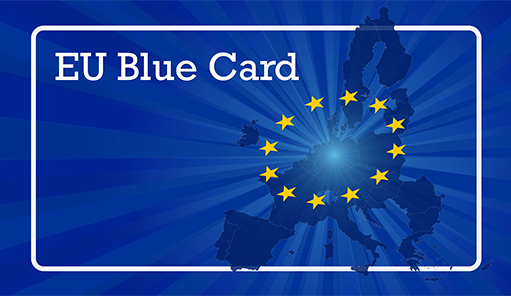
Background of the EU Blue Card
Modelled on the US, the scheme was meant to provide comprehensive socio-economic rights. Applicants could enjoy free movement within the Schengen area, as well as working conditions and salaries that equalled local nationals. On top of that, they were promised a bundle of socio-economic rights, like unemployment benefits and a clear path to permanent residence.
Following the implementation of the scheme all Member States would be free to issue Blue Cards, apart from UK, Denmark and Ireland, by their own choice.
More restrictive than the alternative
As it happened, the original Blue Card was under-used by all but Germany and Luxembourg. Between 2013 and 2020 around 80,000 Blue Cards were issued. This is only 1.3% of the national work and residence permits issued within the EU throughout the same period (6.2 million).
For most Member States, the Blue Card was considered more restrictive than the equivalent national work and residence permits. There were two primary reasons for this:
- the advantages of the Blue Card are mostly for the employee and did not benefit the employer, and
- in many countries, the application process was more difficult for the Blue Card than for national schemes.
The very thing it was meant to fix – the ability for an individual to live and work anywhere in the EU using the same permit – did not work. Even where an individual held a Blue Card in one country, it was often easier to apply for a new card in the new country than apply to transfer the old one.
A new dawn?
 These shortcomings were recognised by the European Commission, who proposed a revamp of the scheme in 2016. This was adopted by the European Council in 2021, with a directive for the Member States to adopt it by November 2023.
These shortcomings were recognised by the European Commission, who proposed a revamp of the scheme in 2016. This was adopted by the European Council in 2021, with a directive for the Member States to adopt it by November 2023.
Initial proposals included a single permit to cover all EU Member States, provided a job offer was present. Another proposal moved to ban parallel schemes targeting highly skilled migrants. Both proposals were dropped during the negotiation.
The final proposal was more modest, but still offered a significant improvement:
- The length of the work contract is reduced to 6 months from 12 months.
- Time that needs to be spent in the first Member State before obtaining permission to reside in another Member State is shortened to 12 months from 18 months.
- Blue Card holders are able to work for up to 90 days in other Member States without having to obtain a work permit from that Member State.
- The new standard validity period of the Blue Card will be at least 24 months (was 12 months) or the length of the contract plus three months.
- A renewal of the EU Blue Card is issued for at least 24 months.
- A decision on the EU Blue Card should be received within 60 days (from 90 days).
- The decision period to receive the EU Blue Card is a maximum of 30 days for ‘recognised employers’.
- The salary threshold for applicants is reduced to at least 100% and not more than 160% of the average gross annual salary in the Member State of employment. Under the current scheme the threshold is 150% minimum with no upper limit.
- Holders of a Blue Card are allowed to exercise a self-employed activity in addition to the profession of their Blue Card.
- Years of residence may be transferred to another Member State if the last two of the previous five years have been spent in the EU with a Blue card.
- Any long-term EU resident who is a former Blue Card holder may stay outside the EU for up to two years.
Finally, the new EU Blue Card makes it mandatory for Member States to recognise professional experience as an alternative to higher education qualifications. In place of a diploma, applicants that work on Intra-Corporate Transfer (ICT) must have three years of work experience over the previous seven years.
The Future of the EU Blue Card
 The new EU Blue Card directive has some great new additions. If properly implemented across all EU Member States, it could have a great impact on EU migration.
The new EU Blue Card directive has some great new additions. If properly implemented across all EU Member States, it could have a great impact on EU migration.
However, as usual, EU Member States have dragged their feet. So much so that, at the time of writing, only Bulgaria has actually implemented the new directive. Meanwhile, a few others have at least issued details on how they would implement the scheme.
Germany, Spain and Sweden are notable exceptions. This is particularly significant for Spain, who did not previously use the Blue Card scheme at all but has now seen an opportunity to attract additional talent through the initiative.
For Germany, as the biggest user of the existing scheme and a key driver of legislation in the EU, it is not surprising that they have decided to implement on time, adopting all key elements of the directive. Most notably a lowered salary criteria is significant, which will benefit a range of professionals.
Across the three countries mentioned, the ability to work in another EU country for three months, like for the ICT permit, is significant and is a development that will benefit employers. Similarly, the reduced processing times, renewal process and contract will help employers have more clarity and certainty, which will be great.
With all the advantages of the renewed scheme, the Blue Card remains more an employee than employer benefit. Worse still, while in theory pan-EU work and travel is great, the new directive runs the risk of draining talent from poorer EU nations that could possibly be a gateway for highly skilled migrants to move to Germany, France etc.
Lastly, despite all the positives, immigration analysts are predicting that the new directive will not yield any particular increase in uptake of the scheme despite the new benefits.
The jury is out on whether it will work. At AGS, we’ll continue to provide updates as things change – as we’re sure they will.
Follow us on LinkedIn to keep up with this and other news from the world of Global Mobility and International HR.














